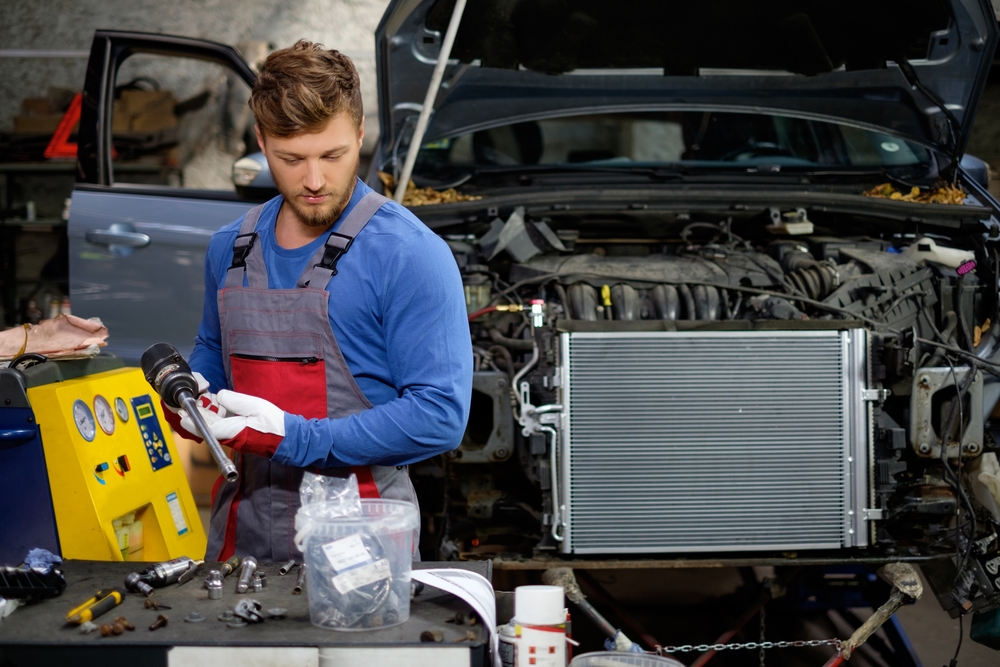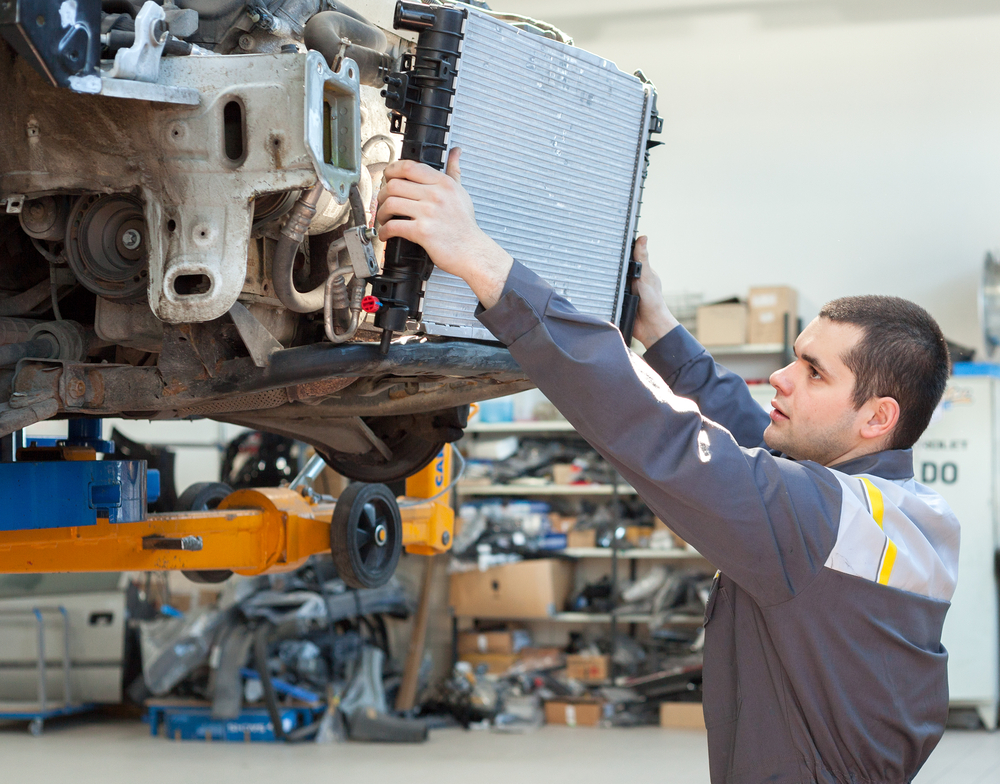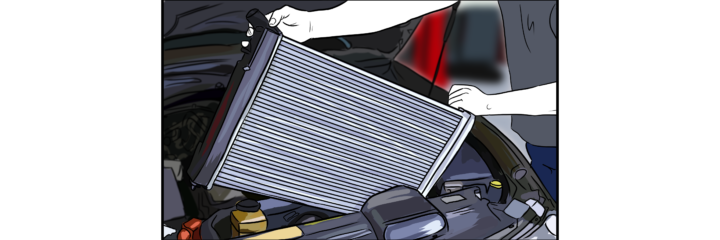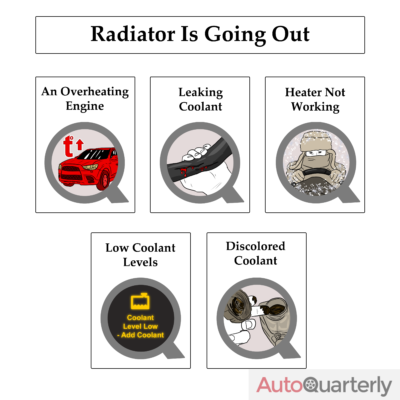There are three things you never want to see: a funnel cloud on the horizon, a dorsal fin sticking out of the water next to you, and steam coming out from under your hood.
While having your radiator go out may not sound as bad as a tornado or a shark attack, at least those things are free. Replacing your radiator, on the other hand, is going to cost you.
The question, though, is how much will it cost you? Is this merely an annoying repair, or is it one of those go-into-debt-for-months jobs?
A lot of that will depend on where you get it done and whether there’s been any other damage to the car, but even so, we can still give you a rough estimate of what you can expect the final bill to look like.
Below, we’ll walk you through everything you need to know about replacing your radiator so that you don’t experience any nasty surprises while you’re at the repair shop.
What Does a Radiator Do, Anyway?
Your radiator is part of your engine’s cooling system. Things get hot underneath your hood, as all those fast-moving parts create a ton of friction. If you don’t cool your engine down, it will quickly overheat — and that can lead to important parts like your cylinder heads warping or melting.
To combat this, your car has coolant (also known as “antifreeze”) running through the engine. Coolant is a liquid that absorbs the car’s heat and carries it away from the engine, taking it to the radiator. The radiator’s job is to cool this fluid off before it travels back into your engine.
The radiator is one of the largest parts you’ll find under your car’s hood. It needs to be big because spreading the coolant out helps it dissipate heat quickly, but that’s not the only way in which the radiator cools it off.
Inside the radiator is a system of aluminum tubes. The antifreeze is passed back and forth through these tubes, losing heat along the way. The radiator also sucks in air from outside the engine through a vent system, and it has a fan that blows the outside air over the aluminum tubes, cooling the fluid inside off even faster.
Your car has a thermostat between the engine and radiator as well. Once the coolant reaches an acceptable temperature, it will be sent back to the engine to repeat the process all over. Conversely, if the coolant starts getting too hot, it will be diverted to the radiator to be cooled again.
How Can You Tell if Your Radiator Is Going Out?
As you might expect given the vital task it has to perform, it’s a very bad thing when your radiator goes out. Fortunately, they rarely break all of a sudden; instead, they’ll give you a few telltale signs that they’re about to fail beforehand.
Here are a few things to be on the lookout for:
An Overheating Engine
This is the biggest warning sign that something’s wrong with your radiator, and it’s something that never should be ignored.
There are times when it might be expected that your engine would overheat — like if you’re driving through Death Valley in July with the A/C on full-blast, for instance. However, if your car’s getting too hot during a normal drive, you should be concerned.
An overheating engine doesn’t always mean the entire radiator needs to be replaced, though. It may mean you need a new thermostat or to swap out your coolant. Regardless, it’s something that you should have your mechanic check out immediately.
Leaking Coolant
Many auto experts call antifreeze “liquid cooling gold” because of how important it is for your car’s health. Okay, so we made that nickname up, but it’s still essential to have plenty of coolant running through your engine at all times.
That’s why a coolant leak should be taken seriously. If you notice a bright yellow, green, or red liquid dripping underneath your car, take it into the shop immediately. It doesn’t necessarily mean that your radiator is shot — but your radiator will be damaged if you wait too long to address the issue. A whole lot of other things might break in the meantime as well.
Quick tangent: if you do spot a coolant leak, clean it up immediately. Antifreeze is deadly to most pets (and it’s not good for groundwater, either), so you don’t want your furry friends licking it up while you’re not looking.
Heater Not Working
When you turn your heater on, much of that hot air is actually coming from your engine — it’s the air that the radiator is blowing over the coolant.
If the heater in your cabin isn’t working, it may mean that your radiator is cracked or clogged.
Low Coolant Levels
If you see a warning sign on your dash that indicates your cooling levels are low, it may not be a big deal. You can just add some more antifreeze and go on about your business.
However, if you’re constantly having to add more coolant, that means you have a leak — and we’ve already seen that coolant leaks are bad for business.
Discolored Coolant
As mentioned previously, most antifreeze is red, yellow, or green. If it’s any other color — especially if that color is black like oil or a rusty brown — then it likely means there’s contaminant buildup happening in your radiator.
This can cause a variety of issues with your radiator’s performance. There are several possible solutions, including flushing the radiator, but that’s a decision that’s best left to your mechanic.
How to Tell if Your Radiator Has Gone Bad

All of the signs above are indications that your radiator might be going bad — so how can you tell if it’s officially kicked the bucket?
The most common way people find out that their radiator has gone bad is when their car suddenly stops running and steam shoots out from underneath the hood. If this happens, you may still be able to drive home if you wait a few minutes for your engine to cool, but the next place you drive should definitely be to your local mechanic.
Beyond that, you’ll likely have to be told by your mechanic that it’s time for a new radiator — usually because you brought your car in due to one of the problems listed above.
Don’t Drive With a Bad Radiator
Also, while you might be tempted to try to milk just a few more miles out of your car, you shouldn’t drive with a broken radiator. If your car overheats, certain parts can melt or become deformed, and that can cause your repair bill to skyrocket.
While replacing your radiator might be expensive (more on just how expensive in a minute), it can also be something of a relief. Once you have a new, mint-condition radiator installed, you won’t have to remember to carry a bottle of antifreeze in the trunk or stress about breaking down on the side of the freeway.
How Much Will It Cost to Replace Your Radiator?
There are a few factors that will affect the cost of your radiator replacement, such as:
- The make and model of your car
- Your mechanic’s labor costs
- Your ability to do the repairs yourself
- Whether any other parts need to be replaced as well
Let’s look at these factors one-by-one.
The Make and Model of Your Car
As you might expect, higher-end cars require higher-end parts — and that means your bill will be higher as well. It costs a lot more to replace the radiator on a BMW than a Kia, for example.
Unfortunately, this is one of those issues you can’t do much about once your radiator goes out. However, the cost of replacement parts is something worth thinking about the next time you’re in the market for a new ride.
Also, some cars are much more complicated than others, which means it takes longer to finish the job. On average, it can take anywhere from 1 to 5 hours to replace a radiator (not counting time spent on replacing other parts).
Labor Costs
Different mechanics will have different hourly rates, and sadly, it’s very difficult to tell ahead of time whether the expensive repair guy is really better than the cheap one.
If you don’t already have a mechanic you can trust, you should ask your friends and family if they have one they can recommend. If this doesn’t drum up any leads, your best bet is to do some research on the internet.
Check to see if the mechanic you’re considering has reviews online, and always look them up on the Better Business Bureau website before you turn them loose on your car. Get a few quotes while you’re looking as well — don’t just settle for the first place you find.
One more thing about labor costs: getting repairs done at the dealership you bought your car from will almost always be more expensive. However, they may be more reliable than many of the garages out there, and they may have some perks that are worth checking out, such as guarantees on the labor or free loaner cars while the job’s being done (these might have been thrown in as a sweetener to get you to buy that BMW in the first place).
Your Ability to Do the Repairs Yourself
If you’re knowledgeable about cars, you may be able to replace the radiator yourself, saving a bit of money on repair costs. Just know that in most cases parts cost more than labor, so you might not save as much as you’d expect. Also, you may have to pay a shop to drain and dispose of the used coolant for you anyway.
Then again, if you’re capable of replacing your own radiator, you might be capable of finding a used one at a scrapyard or pull-a-part store as well. This will likely be much cheaper, but the radiator won’t last as long, so you might have to repeat the process in a year or two.
While you will save money doing things yourself, you won’t have any protection in case you screw it up. You need to either be confident in your abilities or willing to risk your car’s health, because the last thing you want is to do a lot of unnecessary damage.
Replacing a radiator isn’t rocket surgery, but it can be a bit tricky, so it may not be the best job for rookies. Also, we don’t want to scare you, but if you mess up even one tiny little bit, the car will explode. (Note: this won’t happen… probably.)
Whether Any Other Parts Need to Be Replaced
When you have your radiator replaced, the shop may do some other repairs as well. This may mean replacing the hoses, thermostat, water pump, and heater core.
The radiator will likely be the biggest expense, but those other little things add up. Also, they extend the amount of time required to complete the job, driving up labor costs.
If you get your radiator replaced before your car overheats, you may not need to buy anything besides a new radiator. However, if you wait too long, the excess heat may damage the entire cooling system, making everything more expensive.
The Average Cost of Replacing a Radiator

It’s impossible to give an exact estimate of what a radiator replacement will cost due to all the variables listed above, but below are some baseline numbers that should give you an idea of what lies in store for your pocketbook.
| Repair | Parts | Hourly Labor (mechanic) | Hourly Labor (dealer) | Total Cost |
| Radiator | $100 – 400 | $50 – 150 | $100 – 250 | $300 – 700 |
| Hoses | $50 – 100 | $50 – 150 | $100 – 250 | $150 – 175 |
| Thermostat | $20 – 100 | $50 – 150 | $100 – 250 | $75 – 200 |
| Coolant | $10 – 30 | $50 – 150 | $100 – 250 | $50 – 100 |
| Water Pump | $50 – 200 | $50 – 150 | $100 – 250 | $400 – 600 |
| Heater Core | $80 – 250 | $50 – 150 | $100 – 250 | $500 – 800 |
As you can see, replacing your radiator is going to be expensive any way you slice it. However, it’s the other costs that can really eat you alive, which is why you should never ignore a radiator problem.
Tips for Getting More Life Out of Your Radiator
Unless you just have some sort of fetish for giving money to auto mechanics, you’ll likely want to get as much use out of your car’s radiator as you can. Fortunately, there are a few things you can do to prolong the lifespan of this expensive part.
Change Your Coolant Regularly
This is by far the most important thing to do if you want your radiator to last. How often you’ll need to change the coolant will depend on your car and the type of antifreeze used, but typically manufacturers recommend replacing coolant every 100,000 miles or 5 years, whichever comes first.
You may want to do it even more often than that, though — some experts recommend replacing the coolant every 2 or 3 years. Given that this is a cheap and easy procedure, it’s definitely something you shouldn’t skip.
Flush Your Radiator Regularly
Contaminants like rust and scale deposits can build up inside your radiator, clogging the system and preventing your radiator from working properly. Flushing the radiator removes all that gunk, leaving the entire system clean and clear.
It’s worth noting that flushing a radiator isn’t the same as replacing the coolant, although you will end up replacing the coolant during the flushing process. Unless you notice that your antifreeze is becoming discolored or your radiator isn’t functioning properly, there’s no need to flush the system (unless you just want to do so as a preventative measure). Otherwise, you can adhere to the 5 years/100,000 miles guideline listed above.
Keep the Radiator Cap Shut Tightly
Your radiator needs to be pressurized in order to work effectively. If the cap isn’t on tightly (or if it’s cracked or broken), air can escape, interfering with the radiator’s ability to cool the engine. This also lets precious coolant evaporate, as an unpressurized radiator will be prone to boiling.
Most cars have warning lights that let you know if your radiator cap isn’t securely fastened, so don’t ignore that sign if you see it.
However, if it comes on after you’ve been out driving your car, wait at least 15 minutes to check it. If you open it while it’s still hot, steam can shoot out, potentially causing severe burns.
Check Your Hoses
You should inspect your radiator hoses every time you change your car’s oil. If you spot any leaks or cracks, replace them immediately.
This will help keep your radiator from kicking the bucket, and replacing hoses is much cheaper and easier than buying a new radiator.
Final Thoughts

If you’re looking for a fun way to spend $500 or more, replacing your radiator probably won’t make the list. However, you should take radiator problems seriously, as a bad radiator can cause a host of other problems inside your car’s engine.
The good news is that radiators have a long lifespan, so you likely won’t need to replace yours more than once before you get rid of your car.
Then again, if you like buying new cars, then feel free to ignore your radiator’s cries for help — you’ll definitely need a new car soon enough.




